How To Grow Croton (Codiaeum Variegatum)
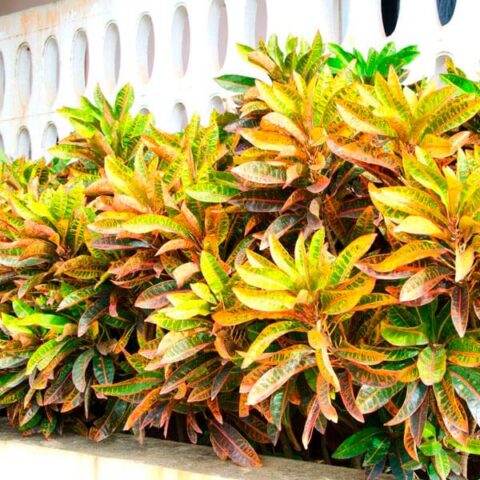
Introduction
If you’re wondering how to grow Croton successfully, this introduction will guide you through the key characteristics, care requirements, and the ornamental value that make Croton a beloved choice for both amateur and experienced gardeners. Croton, scientifically known as Codiaeum Variegatum, is a vibrant and captivating plant that adds a splash of color to gardens and indoor spaces alike. Renowned for its striking and multicolored foliage, Croton is a popular choice among plant enthusiasts seeking a visually stunning and low-maintenance addition to their botanical collections.
With its distinctive variegated leaves, featuring a spectrum of hues ranging from deep greens to vibrant reds, oranges, and yellows, Croton is not only aesthetically pleasing but also a testament to the diversity found in the world of plants.Whether you’re a gardening novice or an experienced plant enthusiast, understanding the ins and outs of how to grow Croton will enable you to enjoy the beauty of this remarkable plant in your own living space
Varieties Of Croton
Croton (Codiaeum Variegatum) boasts a wide range of varieties, each distinguished by its unique combination of colors, patterns, and leaf shapes. Here are several notable varieties of Croton:
Petra Croton (Codiaeum variegatum ‘Petra’)
Petra Croton is a captivating variety known for its vibrant red, orange, and green leaves, making it a sought-after choice for both indoor and outdoor gardening. If you’re wondering how to grow Croton successfully, Petra is a great option with its compact and bushy growth habit. To cultivate Petra Croton, provide well-draining soil, ample sunlight, and moderate watering, ensuring a stunning display of colorful foliage.

Mammy Croton (Codiaeum variegatum ‘Mammy’)
Mammy Croton stands out with its rich burgundy and green leaves, and its colors intensify as the plant matures. For those exploring how to grow Croton varieties, Mammy offers a visually striking option. To nurture Mammy Croton, provide a warm and humid environment, maintain consistent watering, and place it in a location with bright, indirect sunlight for optimal growth.
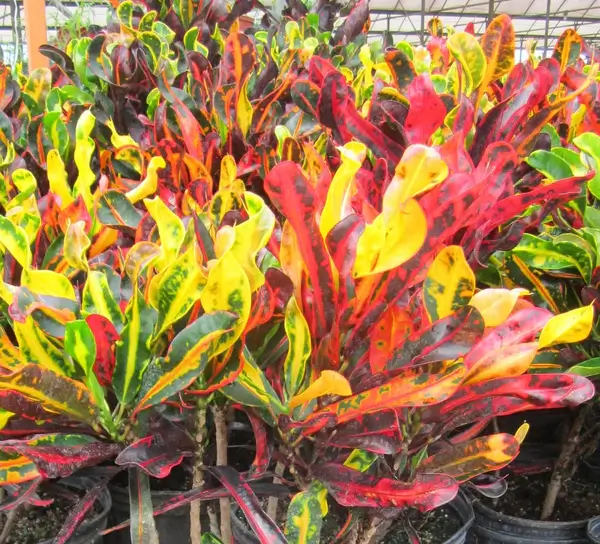
Gold Dust Croton (Codiaeum variegatum ‘Gold Dust’)
Gold Dust Croton is recognized for its bright green leaves adorned with golden-yellow spots, adding a touch of radiance to gardens. If you’re curious about how to grow Croton with unique coloration, Gold Dust is an excellent choice. To cultivate this variety successfully, ensure well-drained soil, moderate watering, and exposure to bright, indirect light for optimal leaf development.

Sloppy Painter Croton (Codiaeum variegatum ‘Sloppy Painter’)
As its name suggests, Sloppy Painter Croton features irregular splashes of color, creating a playful and eclectic aesthetic. For those seeking tips on how to grow Croton with artistic flair, Sloppy Painter is a delightful option. Cultivate this variety by providing well-draining soil, regular watering, and a location with filtered sunlight for the best display of its vibrant, “sloppy” patterns.
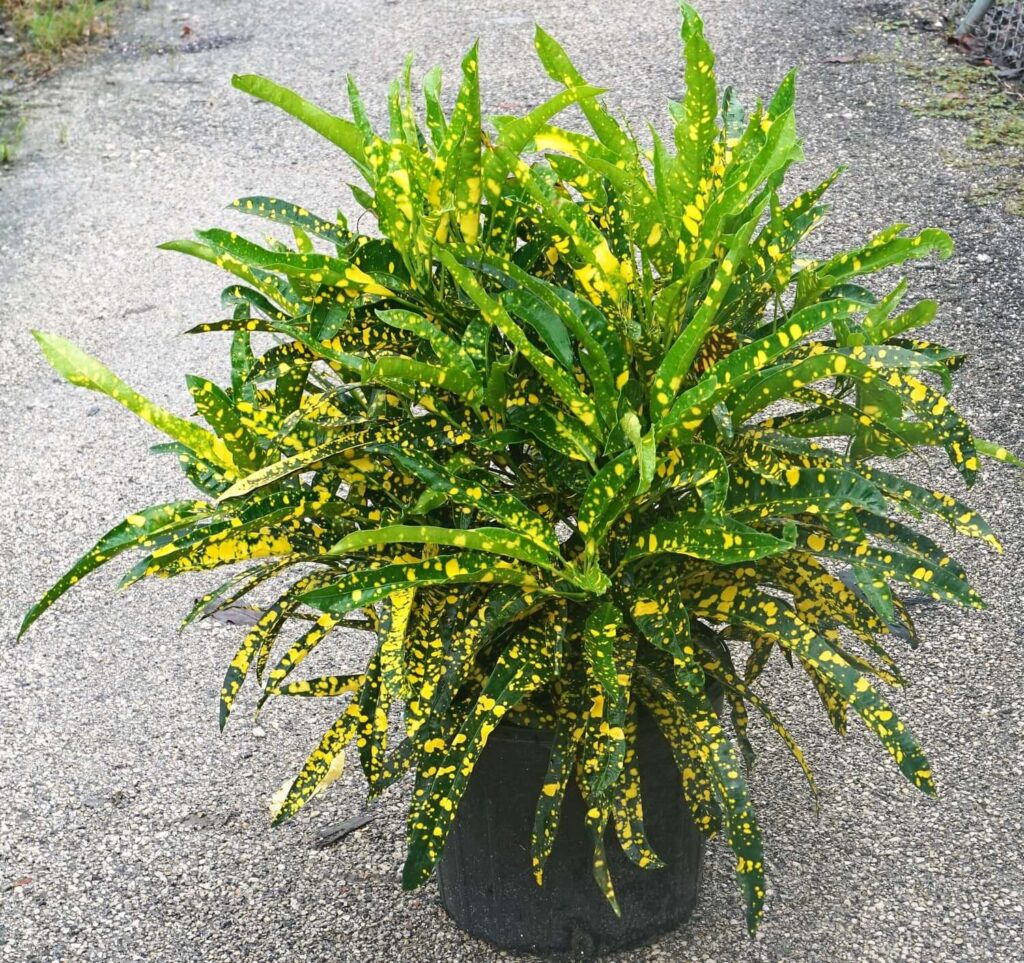
Oakleaf Croton (Codiaeum variegatum ‘Oakleaf’)
Oakleaf Croton is distinguished by its oak-shaped leaves with distinctive lobes, displaying a mix of green, yellow, and red tones. If you’re pondering how to grow Croton varieties with unique leaf shapes, Oakleaf is an attractive choice. To nurture Oakleaf Croton, ensure a warm environment, well-draining soil, and consistent watering to maintain its characteristic foliage.
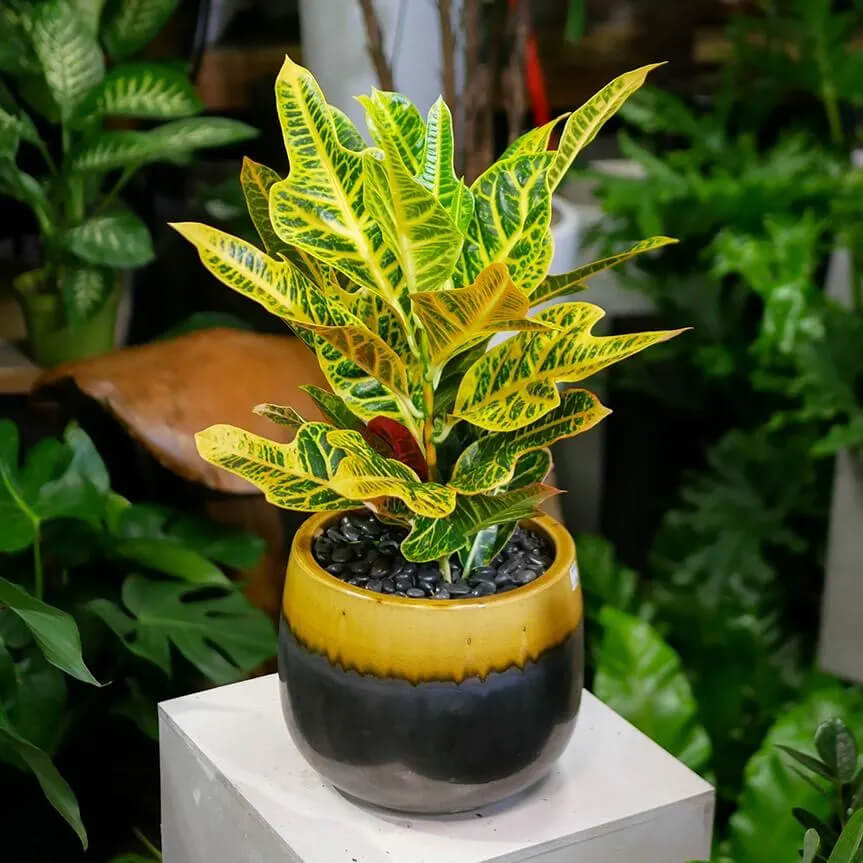
Norma Croton (Codiaeum variegatum ‘Norma’)
Norma Croton boasts broad, lance-shaped leaves with a mix of red, orange, and yellow hues. Whether you’re new to gardening or seeking insights on how to grow Croton with diverse leaf colors, Norma is a versatile option. Cultivate Norma Croton by providing well-drained soil, bright indirect light, and moderate watering for optimal growth and color vibrancy.
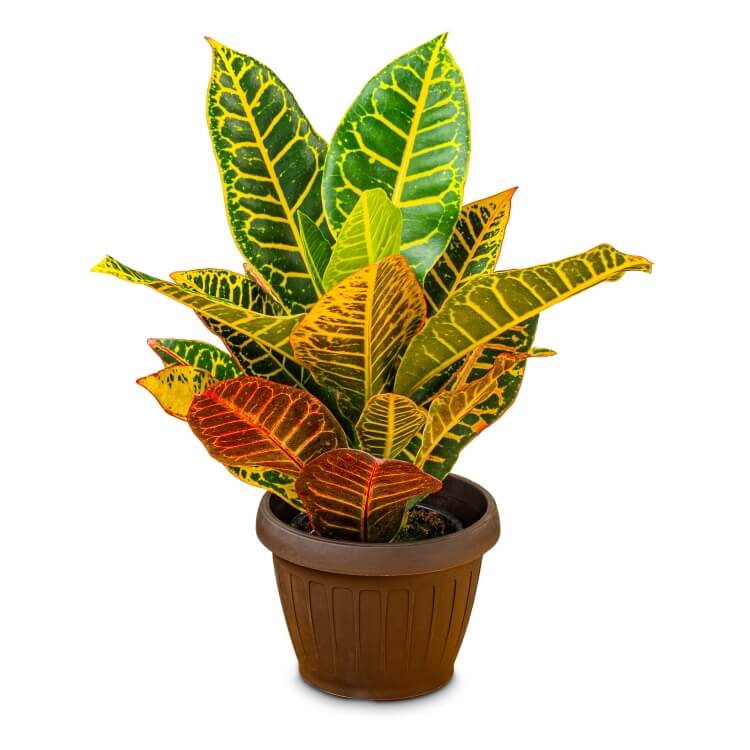
Andreanum Croton (Codiaeum variegatum ‘Andreanum’)
Known for its large, glossy leaves and vibrant color palette, Andreanum Croton adds a tropical touch to gardens and landscapes. If you’re exploring how to grow Croton varieties with a tropical flair, consider Andreanum. Cultivate this variety in well-drained soil, provide adequate sunlight, and maintain a humid environment for lush, tropical foliage.
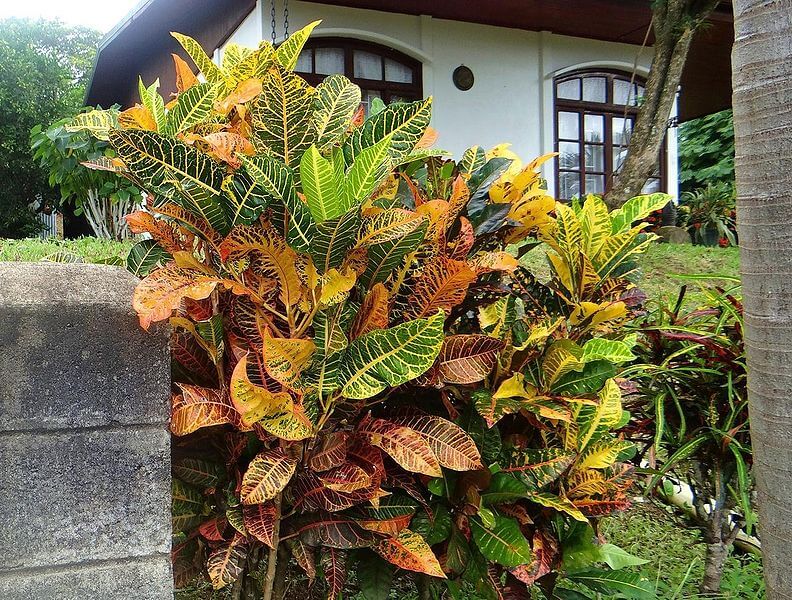
Eleanor Roosevelt Croton (Codiaeum variegatum ‘Eleanor Roosevelt’)
Eleanor Roosevelt Croton, named in honor of the former First Lady, showcases bold and contrasting leaf patterns with a mix of deep greens, reds, and yellows. For those interested in how to grow Croton varieties that make a statement, Eleanor Roosevelt is an excellent choice. Cultivate this variety with well-draining soil, bright indirect light, and regular watering to highlight its unique leaf patterns.
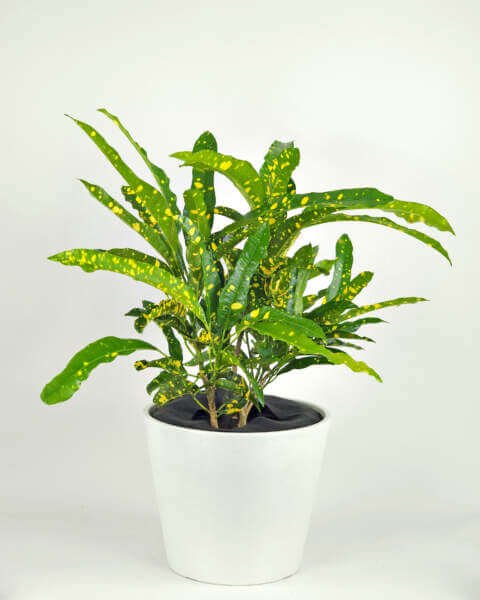
Zanzibar Croton (Codiaeum variegatum ‘Zanzibar’)
Zanzibar Croton features narrow, elongated leaves with a mix of green, yellow, and orange hues, adding elegance to indoor spaces. If you’re wondering how to grow Croton varieties for indoor decor, Zanzibar is a graceful option. Cultivate this variety in well-drained soil, provide bright, indirect light, and maintain consistent humidity for optimal growth and visual appeal.

Magnificent Croton (Codiaeum variegatum ‘Magnificent’)
Magnificent Croton lives up to its name with large, wavy leaves and a striking combination of colors. To those seeking insights on how to grow Croton varieties that create a focal point, Magnificent is an ideal choice. Cultivate this variety in well-drained soil, provide ample sunlight, and maintain moderate watering to showcase its impressive and visually appealing foliage.
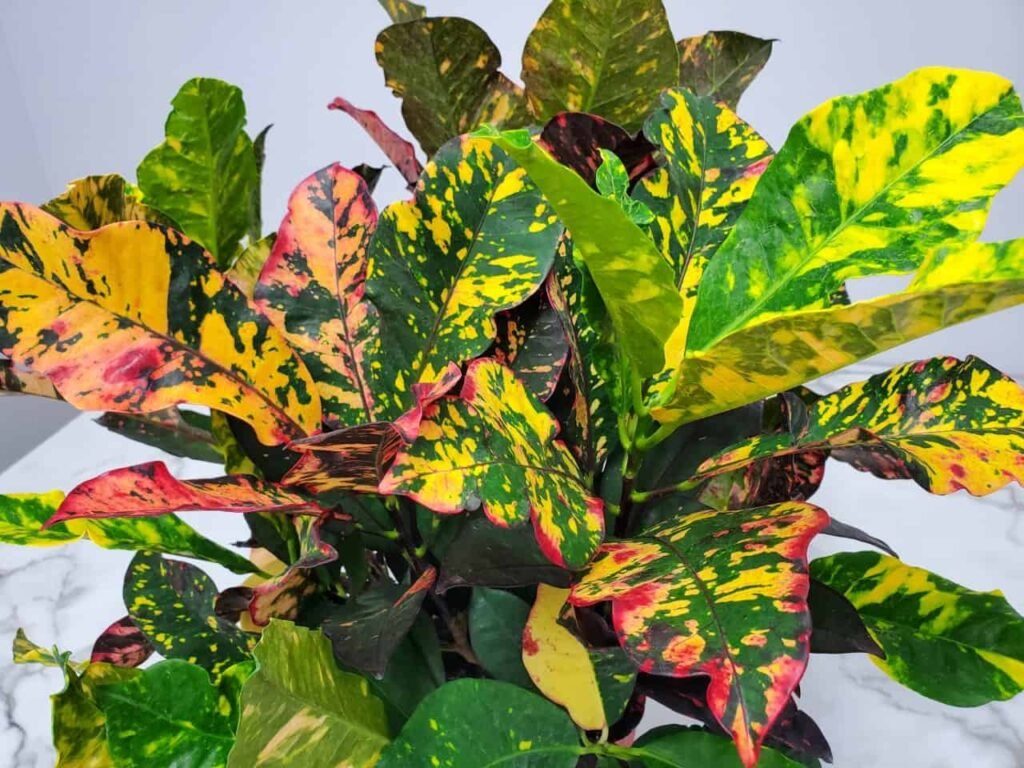
Growing Croton
If you’re wondering how to grow Croton successfully, here are some essential tips to ensure its thriving development:
- Ample Bright Light: Crotons thrive in environments with plenty of bright light. While they can tolerate some direct sunshine, it’s advisable to keep them away from direct midday sun to prevent leaf burn. Understanding how to grow Croton includes providing the right balance of light for optimal photosynthesis.
- Consistent Warmth: Maintain a consistently warm spot for your Croton. These plants prefer warmer temperatures and may suffer in colder conditions. Knowing how to grow Croton involves creating a warm and stable environment to support healthy growth.
- High Humidity: Crotons appreciate high humidity levels. You can achieve this by misting the leaves regularly or placing the plant on a tray of moist pebbles. Adequate humidity contributes to lush foliage, an important aspect of understanding how to grow Croton successfully.
- Moderate Watering: Keep the soil consistently moist during the growing season, which typically spans from spring to autumn. While Crotons like humidity, be cautious not to overwater, as soggy soil can lead to root issues. Mastering how to grow Croton includes finding the right balance in watering to prevent both drought stress and root rot.
- Temperature Considerations: Maintain a minimum temperature of 15°C (59°F) for your Croton. These plants prefer warmth and may suffer in cooler conditions. Avoid placing them in rooms with regular temperature fluctuations or drafts, as stability is key to their well-being.
By providing the right conditions – bright light, consistent warmth, high humidity, and careful watering – you’ll create an environment in which your Croton can thrive and showcase its vibrant and colorful foliage. Understanding how to grow Croton is key to enjoying the beauty of this unique and striking plant.
Planting a Croton Plant: Step-by-Step Guide
When it comes to planting a Croton plant, follow these simple steps to ensure a successful and healthy start:
- Choose the Right Pot and Soil: Select a pot that is the same size or slightly larger than the root ball of your Croton plant. Opt for soil-based compost to provide the necessary nutrients for growth.
- Prepare the Pot: Fill the chosen pot with the soil-based compost, leaving enough space for the root ball. Ensure the pot has drainage holes to prevent waterlogging, promoting proper moisture levels for the Croton.
- Remove the Croton from its Container: Carefully remove the Croton from its existing container, taking care not to damage the roots. Gently tap the bottom and sides of the container to loosen the soil and facilitate an easy extraction.
- Position the Croton in the Pot: Place the Croton in the center of the prepared pot, ensuring that the top of the root ball sits slightly below the rim. This allows for proper watering without soil spillage.
- Fill the Surrounding Space: Fill the remaining space in the pot with the soil-based compost, pressing it down gently to secure the plant. Leave a small gap between the soil surface and the rim of the pot for easy watering.
- Watering: After planting, water the Croton thoroughly to help settle the soil and provide initial hydration to the roots. Ensure that excess water can drain freely from the pot.
- Repotting Routine: Wear gloves when handling the Croton, as its sap can cause skin irritation. Repot every two or three years in the spring if the plant becomes root-bound, moving it into a slightly larger pot to accommodate its growing roots.
By following these steps and wearing protective gloves, you can cultivate Croton effectively, promoting healthy growth and vibrant foliage.
How to Propagate Croton Plants: Step-by-Step Guide
If you’re wondering how to grow Croton and propagate it successfully, taking softwood cuttings is a method worth exploring. Follow these steps for effective propagation:
- Choose the Right Stem: Wearing gloves, select a stem that is approximately the thickness of a pencil and around 12cm long. Cut it at a 45° angle just above a node to encourage successful root development. This is a key step in understanding how to grow Croton through propagation.
- Prevent Sap Bleeding: To prevent sap bleeding, consider dipping the end of the cut stem in powdered charcoal. This helps in maintaining the plant’s health during the propagation process, an important aspect of how to grow Croton from cuttings.
- Prepare the Cutting: Remove the growing tip and most of the leaves from the selected stem, focusing on creating a clean and healthy cutting for propagation.
- Potting in Gritty Compost: Place the prepared cutting in a small pot filled with gritty compost. Cover the cutting with a clear plastic bag to maintain high humidity levels. Adequate humidity is crucial when learning how to grow Croton cuttings successfully.
- Provide Warmth and Bottom Heat: Keep the pot in a warm spot, preferably with some bottom heat to encourage root development. This is a key factor in how to grow Croton cuttings, as warmth aids in the establishment of a healthy root system.
- Regular Watering: Water the cutting thoroughly after potting to settle the compost and provide initial hydration. Ensure the pot has proper drainage to prevent waterlogging.
By following these steps, you’ll master the art of how to grow Croton through propagation.
Troubleshooting for Growing Crotons
Encountering challenges while learning how to grow Croton is common, but with proper problem-solving techniques, you can ensure the health and vitality of your plants.
Dropping Leaves
One common issue is leaf drop, which indicates problems with the plant’s growing conditions. This may occur if the soil is excessively wet or dry. Additionally, moving the plant to a new spot can trigger leaf drop. Understanding how to grow Croton involves maintaining balanced soil moisture and avoiding frequent relocations.
Fading Leaves
If your Croton exhibits fading leaves, it likely needs more sunlight. To address this, ensure the plant receives approximately 4-5 hours of direct sunshine. However, be cautious and avoid midday sun exposure to prevent leaf burn. Knowing how to grow Croton includes providing the right amount of sunlight for optimal growth.
Brown Leaf Tips
Brown tips on the leaves are indicative of dry surroundings, either in the air or compost. Mastering how to grow Croton involves addressing this issue by increasing humidity levels or adjusting the moisture content in the compost. Regular monitoring and adjustments are key to preventing dryness-related problems.
Brown Edges on Leaves
Cold room conditions can result in brown edges on Croton leaves. Understanding how to grow Croton successfully includes maintaining a warm environment to prevent cold stress. Ensure the room temperature is suitable for the plant’s well-being.
Red Spider Mite Infestation
Red spider mites can affect Crotons, leading to fine webbing on leaves and mottling on the upper surface. Learning how to grow Croton involves addressing this issue by improving air circulation and boosting humidity. Alternatively, use sprays containing fatty acids or plant oils for effective control.
Scale Insect Problems
If you observe raised brown spots on the leaves, scale insects may be the culprit. To address this issue in your journey of how to grow Croton, wipe them off with a damp cloth or cotton bud soaked in an insecticide containing fatty acids or plant oils.
By identifying and addressing these common issues, you’ll enhance your knowledge of how to grow Croton and ensure a thriving and vibrant plant. Regular monitoring and prompt action are key to maintaining the health and beauty of your Crotons.
Tips for Purchasing a Croton Plant
Acquiring a Croton plant is an investment, and to make the most of it, consider the following advice before making a purchase:
- Understand Growing Conditions: Crotons require specific growing conditions. Before buying, ensure you can provide the necessary light, warmth, and humidity for optimal growth. Understanding the plant’s needs is crucial in successfully caring for it.
- Explore Specialist Shops: For the best selection of Croton cultivars, consider visiting specialist house plant shops or exploring online house plant retailers. These outlets typically offer a diverse range of varieties, allowing you to choose the Croton that suits your preferences.
- Inspect Foliage Health: When examining potential purchases, check for lush foliage without any signs of damage or pests. Healthy leaves are indicative of a well-cared-for plant. Inspecting the foliage closely ensures you bring home a Croton that is in prime condition.
Investing in a Croton plant is a commitment, and by following these tips, you’ll increase the likelihood of selecting a healthy and thriving specimen. Understanding the plant’s needs and choosing from reputable sources will contribute to a rewarding and visually appealing addition to your indoor garden.
Caution with Croton: Poisonous and Irritating
Exercise caution when dealing with Croton (Codiaeum Variegatum) as all parts of the plant, especially the seeds, are poisonous. This makes it unsuitable for homes with curious pets or children who might inadvertently ingest its toxic components. Furthermore, if the plant is damaged, it releases a milky sap that can cause skin irritation. Handle Croton with care, and consider wearing protective gear to avoid direct contact with the irritating sap. While Croton is prized for its vibrant foliage, responsible precautions are essential to ensure the safety of both humans and pets in the vicinity.
Conclusion
In conclusion, cultivating Croton plants is a rewarding journey that elevates the aesthetic appeal of any botanical collection. Delving into how to grow Croton is not merely a task but an exploration of creating an environment that nurtures the unique characteristics of these plants. The diverse range of varieties, from the lively Petra to the regal Mammy, offers a spectrum of colors and patterns, allowing you to curate a garden that reflects your personal style.
Understanding how to grow Croton encompasses providing optimal conditions. This involves ensuring they receive the right amount of bright light, maintaining a warm atmosphere, and considering the humidity levels to encourage their vibrant and healthy growth. The Petra, with its vivid hues, or the graceful Mammy, each variety demands attention to detail in care practices, highlighting the significance of learning how to grow Croton effectively.
Investing in a Croton plant is an investment in a dynamic living artwork. As you explore how to grow Croton, you embark on a journey of horticultural mastery, where the reward is not just the foliage but a flourishing and thriving botanical masterpiece. Whether you are a seasoned plant enthusiast or a novice green thumb, the knowledge of how to grow Croton allows you to unlock the full potential of these remarkable plants, bringing nature’s artistry into your everyday living spaces. So, cultivate your Croton with care, and witness the vibrant tapestry of colors unfold, transforming your garden into a living canvas of botanical beauty.
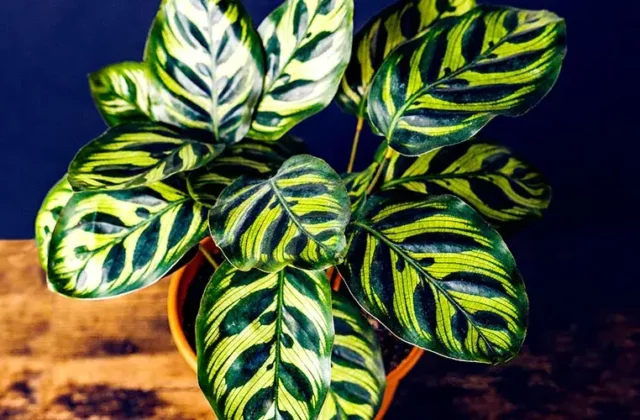
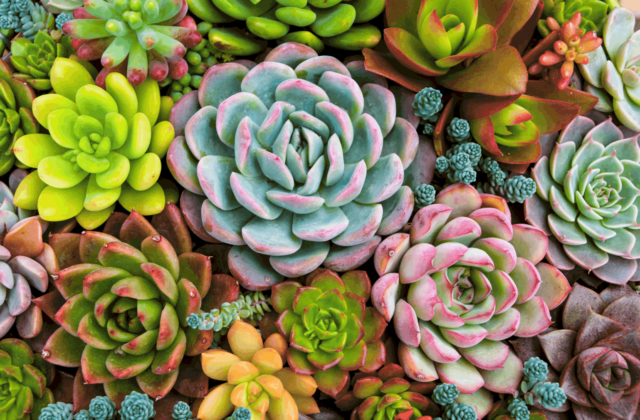
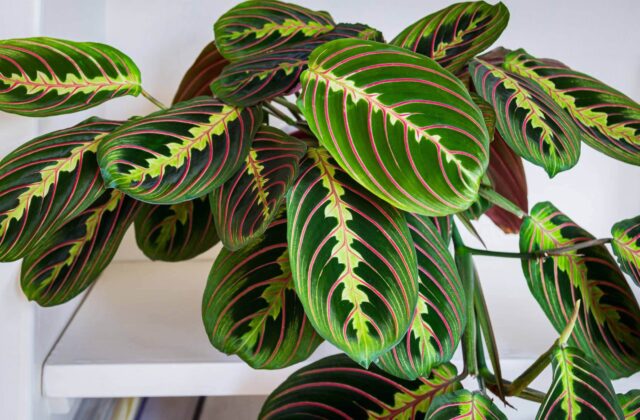
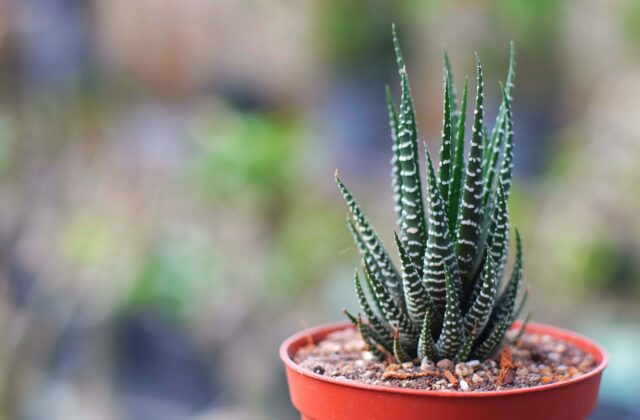
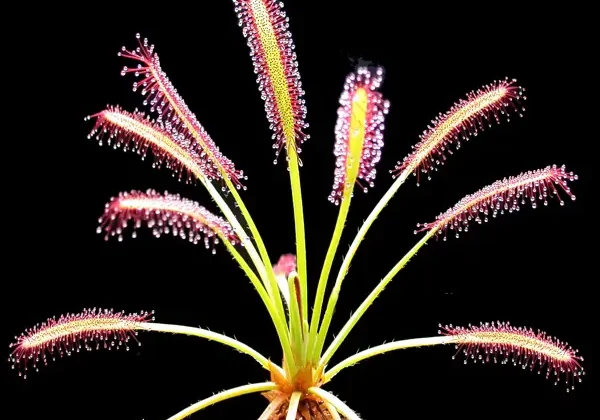
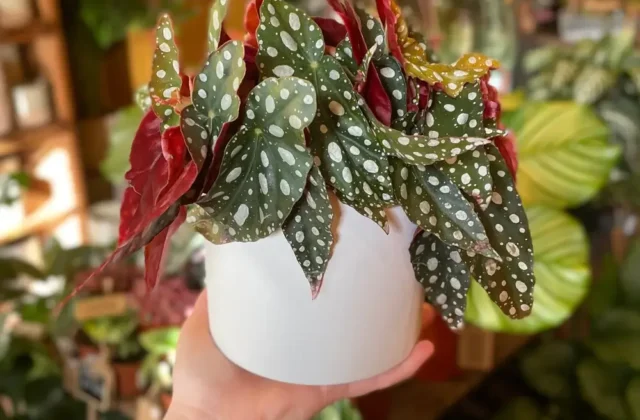
15 comments
Hey there, I’m Natalie from Social Buzzzy , your guide in the exciting world of Instagram growth. I’ve stumbled upon something extraordinary for skyrocketing your Instagram presence and I’m thrilled to share it with you!
Social Growth Engine unveils a groundbreaking service that propels your Instagram engagement to new heights. It’s a breeze:
– Zero in on crafting stellar content.
– Extremely cost-effective at just $36/month.
– Utterly reliable (no password needed), highly efficient, and the ideal Instagram companion.
I’ve witnessed remarkable results firsthand, and I’m sure you will too! Elevate your Instagram presence right now: http://get.socialbuzzzy.com/instagram_booster
To your success,
Your ally Natalie
I have been surfing online more than 2 hours today, yet I
never found any interesting article like yours.
It is pretty worth enough for me. Personally, if all webmasters and bloggers made good content
as you did, the net will be a lot more useful than ever before.
Also visit my blog … vpn coupon code 2024
Hello there! Quick question that’s completely off topic.
Do you know how to make your site mobile
friendly? My blog looks weird when browsing from my
iphone4. I’m trying to find a theme or plugin that might be able to correct this problem.
If you have any suggestions, please share. Cheers!
Take a look at my webpage – vpn code 2024
I like the helpful information you provide in your articles.
I’ll bookmark your blog and check again here regularly.
I’m quite certain I’ll learn plenty of new stuff right here!
Best of luck for the next!
Also visit my page :: vpn special
Thanks a lot for sharing this with all folks you really
recognise what you are talking about! Bookmarked.
Kindly also seek advice from my site =). We can have a
hyperlink alternate arrangement between us
Also visit my webpage … vpn code 2024
Hey, Natalie from Social Buzzzy checking in. I’ve come across a revolutionary tool for Instagram engagement and had to share it with you!
Social Growth Engine offers an incredible tool that boosts Instagram engagement. It’s straightforward:
– Just focus on making incredible content.
– Economical at under $36/month.
– Safe, powerful, and compliant with Instagram.
Having seen incredible results, and I am confident you will too! Boost your Instagram game today: http://get.socialbuzzzy.com/instagram_booster
Cheers your success,
Natalie
Hey! I just wanted to ask if you ever have any problems
with hackers? My last blog (wordpress) was hacked and I ended up losing several weeks of hard work due to no
data backup. Do you have any solutions to protect against hackers?
my homepage – vpn special coupon code 2024
Hello there, Natalie from Social Buzzzy , your ally in the exciting world of Instagram growth. I’ve stumbled upon something phenomenal for skyrocketing your Instagram popularity and I’m thrilled to share it with you!
Social Growth Engine introduces a pioneering service that catapults your Instagram engagement to new heights. It’s effortless:
– Concentrate on producing captivating content.
– Extremely budget-friendly at just $36/month.
– Completely safe (no password needed), exceptionally effective, and the ideal Instagram companion.
I’ve observed remarkable results firsthand, and I’m certain you will too! Boost your Instagram presence today: http://get.socialbuzzzy.com/instagram_booster
Warm regards,
Your ally Natalie
With havin soo much written content do you eever run into aany problems of plagorism or copyright violation?
My blog has a loot of completely unique content I’ve either written myself or outsourced but it sees a lot
oof it is popping it up all over the internet without my authorization. Do you
know any solutions to help prevent contentt from being stolen?
I’d genuinely appreciate it. https://www.waste-ndc.pro/community/profile/tressa79906983/
With havin so much wwritten content do you ever run into
any problems oof plagorism or copyright violation? My blog has a lot of
completely unique content I’ve either written myself or outsourced but
it seems a lott of it is popping it up all over the internet without my authorization. Do you know aany solutions to help pprevent content from being stolen? I’d genuinely appreciate
it. https://www.waste-ndc.pro/community/profile/tressa79906983/
Hey, Natalie from Social Buzzzy checking in. I’ve discovered a revolutionary tool for Instagram engagement and had to share it with you!
Social Growth Engine introduces an incredible tool that elevates Instagram engagement. It’s easy:
– Keep focusing on making fantastic content.
– Cost-effective at less than $36/month.
– Reliable, efficient, and compliant with Instagram.
Having seen amazing results, and I know you will too! Elevate your Instagram game now: http://get.socialbuzzzy.com/instagram_booster
Cheers your success,
Natalie
I was curious if you ever thought of changing the layout of your website? Its very well written; I love what youve got to say. But maybe you could a little more in the way of content so people could connect with it better. Youve got an awful lot of text for only having 1 or two pictures. Maybe you could space it out better?
Your article helped me a lot, is there any more related content? Thanks!
Lovely website! I am loving it!! Will be back later to read some more. I am taking your feeds also
I really enjoy the blog postMuch thanks again Great